Choosing the Best Deployment Option for Dynamics 365 Business Central

Business Central has several popular deployment options: on-premises, on-premises in Azure, and SaaS. Let’s consider the advantages and disadvantages of each.
What is an On-Premises Deployment?
An on-premises (on-prem) deployment of Business Central refers to a deployment model where the software is installed and runs on the customer’s own servers or hardware infrastructure rather than in the cloud.
In an on-prem deployment, the customer manages and maintains the Dynamics 365 Business Central software and the underlying infrastructure, including servers, databases, and networking. The customer must also perform any necessary software updates or upgrades themselves.
An on-prem deployment is often used by businesses with strict regulatory requirements or security concerns requiring them to keep their data and software on their own servers rather than in the cloud. It is also frequently used by businesses that require more control over their software and infrastructure or that have specialized hardware or third-party software integrations that cannot be easily replicated in a cloud environment.
However, an on-prem deployment can have disadvantages, such as higher upfront and ongoing costs for hardware and software, longer deployment times, and higher maintenance costs over time. Additionally, it can be more challenging to scale an on-prem deployment to accommodate growth or changes in business requirements compared to cloud-based deployments like Software-as-a-Service (SaaS) or on-prem in Azure.
What is an On-Premises in Azure Deployment?
In Dynamics Business Central, an Azure deployment model refers to a cloud-based deployment model where the Business Central software is installed and hosted on the Microsoft Azure cloud platform.
In this deployment model, the customer manages and maintains the Business Central software, but Microsoft manages and maintains the underlying infrastructure, including servers, databases, and networking. The customer must also perform any necessary software updates or upgrades, but Microsoft provides tools and guidance to simplify the process.
An Azure deployment can offer several benefits, such as reduced IT costs, more effortless scalability, and improved accessibility. With an Azure deployment, customers can avoid the upfront costs associated with purchasing and maintaining hardware and software on-premises. They can also scale their usage up or down as needed and provide access to the software to employees from any location with an internet connection.
Additionally, an Azure deployment can offer high levels of security and reliability. Microsoft provides advanced security features and redundancy to ensure that the software and data are always available and protected against cyber threats and data loss.
Overall, an Azure deployment can be a good choice for businesses that require the flexibility and scalability of a cloud-based deployment while maintaining more control over their software and data than a SaaS deployment.
What is a SaaS Deployment?
Business Central is an Enterprise Resource Planning (ERP) system developed by Microsoft. A SaaS deployment of Business Central refers to a cloud-based deployment model where the software is hosted and managed by Microsoft on their servers, and customers access the software over the internet via a web browser.
In a Business Central SaaS deployment, customers do not need to install or manage any software on their own servers. Instead, they subscribe to the service and pay a recurring fee to access the software on a subscription basis. Microsoft manages the underlying infrastructure, including hardware, networking, and software updates, ensuring that customers have access to the latest version of the software without needing to perform any upgrades themselves.
SaaS deployment models like Business Central can offer several benefits to businesses, including reduced IT costs, more effortless scalability, and improved accessibility. With a SaaS deployment, businesses can avoid the upfront costs of purchasing and maintaining hardware and software on-premises. They can also scale their usage up or down as needed and provide access to the software to employees from any location with an internet connection.
What Option Should You Choose?
The best deployment model for Business Central depends on your business’s specific needs and requirements. Each deployment model discussed (on-premises, on-prem in Azure, and SaaS) has its own advantages and disadvantages, and you should consider them carefully before deciding.
Here are some factors to consider when choosing a deployment model for your Business Central solution:
- Cost: Consider the upfront and ongoing costs of each deployment model, including hardware, software, licensing, maintenance, and support.
- Scalability: Consider the ability of each deployment model to accommodate changes in the size and needs of your business over time.
- Security: Consider the security measures in place for each deployment model, including data encryption, access control, and backup and recovery options.
- Accessibility: Consider how easy it is for employees to access the software from anywhere, including on mobile devices or from remote locations.
- IT resources: Consider the level of IT resources and expertise required to manage and maintain each deployment model, including software updates, infrastructure management, and user support.
Ultimately, the best deployment model for your business will depend on a combination of these factors and your specific business requirements. You should carefully evaluate each deployment model and work with your IT team and solution provider to choose the best fits your needs.
Trending Posts
Stay Informed
Choose Your Preferences
"*required" indicates required fields
